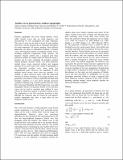Scholte waves generated by seafloor topography
Author(s)
Zheng, Yingcai; Fang, Xinding; Liu, Jing; Fehler, Michael
DownloadZheng_et al_ScholteWave.pdf (2.122Mb)
Other Contributors
Massachusetts Institute of Technology. Earth Resources Laboratory
Metadata
Show full item recordAbstract
Seafloor topography can excite strong interface waves called Scholte waves that are often dispersive and characterized by slow propagation but large amplitude. This type of wave can be used to invert for near seafloor shear wave velocity structure that is important information for multi-component P-S seismic imaging. Three different approaches are taken to understand excitation of Scholte waves and numerical aspects of modeling Scholte waves, including analytical Cagniard-de Hoop analysis, the boundary integral method and a staggered grid finite difference method. For simple media for which the Green’s function can be easily computed, the boundary element method produces accurate results. The finite difference method shows strong numerical artifacts and stagnant artificial waves can be seen in the vicinity of topography at the fluid-solid interface even when using fine computational grids. However, the amplitude of these artificial waves decays away from the seafloor. It is sensible to place receivers away from the fluid-solid interface for seismic modeling. To investigate Scholte wave generation, one needs to correctly implement the fluid-solid boundary condition. It is also shown through numerical examples including using a seafloor profile from the recent SEG Advanced Modeling (SEAM) Project that even mild topographic features can generate Scholte waves and these waves can be used to constrain near seafloor S wave velocity by dispersion analysis of interface Scholte waves. The implication to the full waveform inversion is that, although low frequency data are crucial for convergence, seafloor topography may have a large effect on low frequency seismic waves.
Date issued
2012Publisher
Massachusetts Institute of Technology. Earth Resources Laboratory
Series/Report no.
Earth Resources Laboratory Industry Consortia Annual Report;2012-29
Keywords
Imaging, Scattering, Modeling